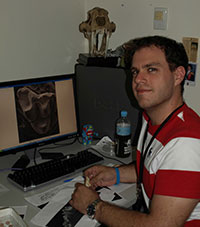K. J. Travouillon School of Earth Sciences
School of Earth Sciences
University of Queensland
St. Lucia
Queensland 4072
Australia
and School of Biological, Earth and Environmental Sciences
University of New South Wales
New South Wales 2052
Australia
Kenny J. Travouillon is a vertebrate palaeontologist and palaeoecologist working at University of Queensland, in the School of Earth Sciences. He received a Bachelor of Science (Hons) and PhD from the University of New South Wales, Sydney, Australia.
His early research aimed at clarifying the chronological position of the Riversleigh World Heritage Area (northwestern Queensland) fossil sites amongst the Tertiary of Australia, in absence of absolute dates, using multivariate analyses as a tool to group sites of similar age based on taxonomic information. His research also aimed at identifying the palaeoenvironments of Riversleigh's sites, using cenograms. Cenograms are a graphical representation of the logged body mass of mammals in a fauna. The shape of the cenogram can be use to predict whether the environment in which the fauna lives is open or closed and humid or arid.
He was recently awarded with the Robert Day Postdoctoral Fellowship at the University of Queensland, working on Peramelemorphian (bilbies and bandicoots) phylogeny and describing new taxa from Riversleigh and Etadunna (South Australia).
![]()
R.M.D. Beck School of Biological, Earth and Environmental Sciences
School of Biological, Earth and Environmental Sciences
University of New South Wales
New South Wales 2052
Australia
Robin Beck graduated with a BA (Hons) in Natural Sciences from Pembroke College, University of Cambridge, in 2002 and an MSc in Advanced Methods in Taxonomy and Biodiversity from the Natural History Musem and Imperial College, London, in 2003. He was awarded his PhD from the University of New South Wales in 2008 for his thesis 'Form, function, phylogeny and biogeography of enigmatic Australian metatherians', which was supervised by Mike Archer and Sue Hand. From 2009 to 2011, he was an NSF-funded postdoctoral research fellow at the American Museum of Natural History, working in collaboration with Rob Voss and Sharon Jansa on the morphology and phylogeny of marsupials. Since 2012, he has been a DECRA postdoctoral fellow at UNSW, studying the only known record of early Palaeogene fossil mammals in Australia, from the early Eocene Tingamarra Fauna. His major research interests are the morphology, systematics and biogeography of mammals (particularly marsupials), and combining morphological and molecular data to resolve phylogenetic relationships and divergence times. He has undertaken fieldwork in Australia, New Zealand and Antarctica.
![]()
S.J. Hand School of Biological, Earth and Environmental Sciences
School of Biological, Earth and Environmental Sciences
University of New South Wales
New South Wales 2052
Australia
Suzanne Hand is a vertebrate palaeontologist and Associate Professor at the University of New South Wales where she teaches zoology and geology. Her research interests are largely in the areas of evolutionary biology, functional morphology, phylogenetics, and biogeography, with a special interest in fossil and modern mammals, particularly bats. She co-leads research of the World Heritage-listed Riversleigh fossil deposits of northern Australia, and is also currently researching fossil mammal faunas in Europe, Asia, New Zealand and New Caledonia. She is the author of 100+ publications on Australian fossil mammals including several books.
Photo: R. Morris
![]()
M. Archer School of Biological, Earth and Environmental Sciences
School of Biological, Earth and Environmental Sciences
University of New South Wales
New South Wales 2052
Australia
Mike Archer was born in Sydney but lived in the USA until 1967 when he moved back to Australia. By age 11 he was addicted to fossil and living animals. Degrees: Princeton University BA, University of Western Australia PhD. Key positions: Professor, University of New South Wales; Director of the Australian Museum, Sydney; Dean of Science, University of New South Wales. Current research foci on which I have published (~16 books & 265 refereed journal articles): evolution of mammals, in particular monotremes and marsupials; evolution of Australia's terrestrial environments over the last 100 million years; biocorrelation of Australia's Cenozoic vertebrates; impacts of palaeoclimate change; use of palaeontological datasets to optimise conservation of living species; innovative biofuel company; conservation through sustainable use of native resources; native animals as pets; battling Creationists; dental function and ontogeny; megafaunal extinctions; biogeographic history of New Zealand; early Cenozoic biotas of Argentina; megatsunamis; science communication; lacustrine and karst geology and petrogenesis; etcetera. I started the Thylacine & Lazarus Projects to see how far we could get in efforts to recover, revitalize and enable ancient DNA to construct functional organisms. For more info: http://www.create.unsw.edu.au/team/marcher/.
![]()

